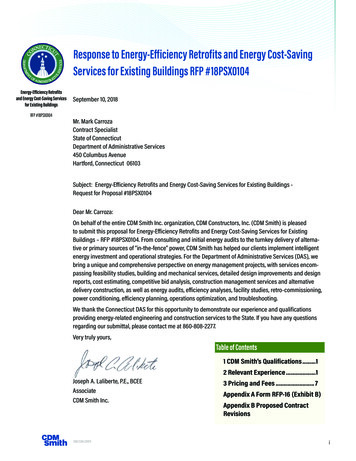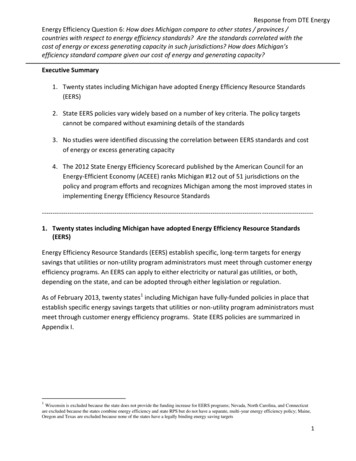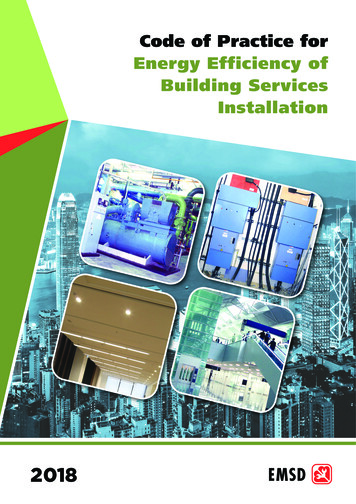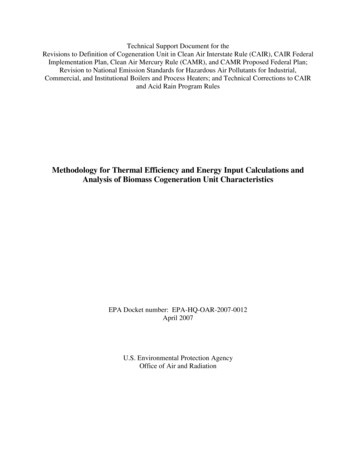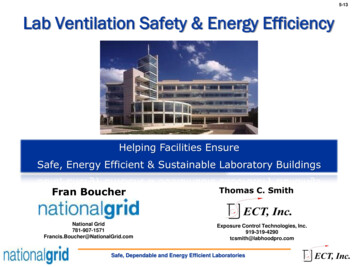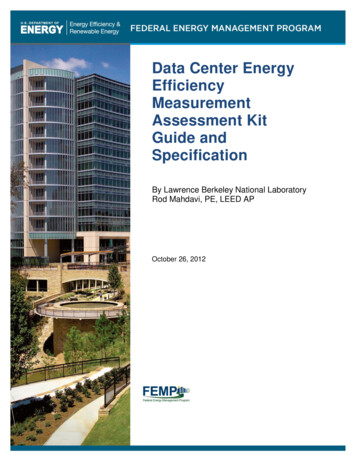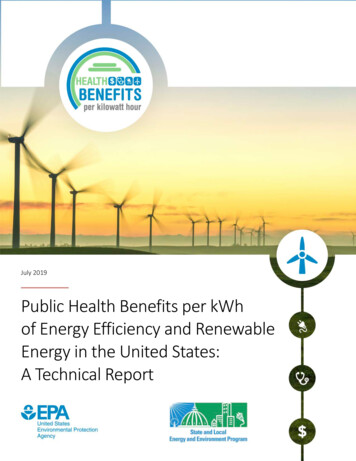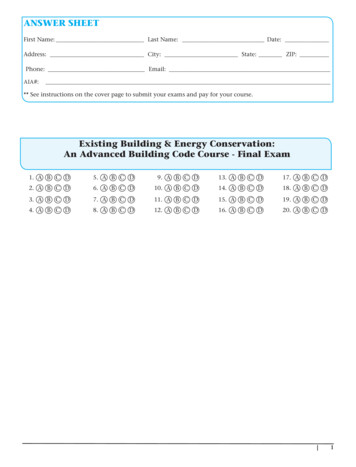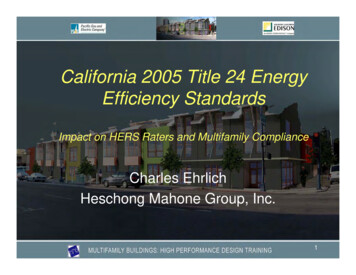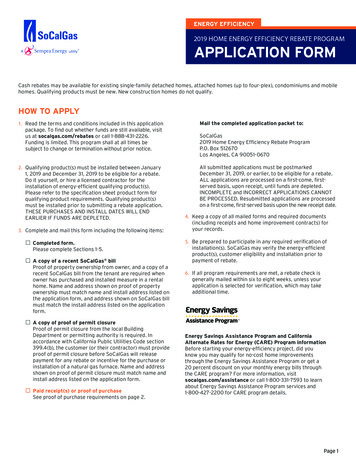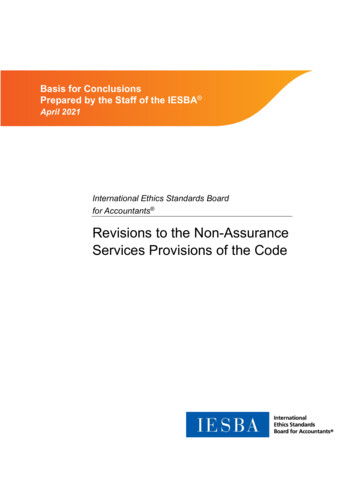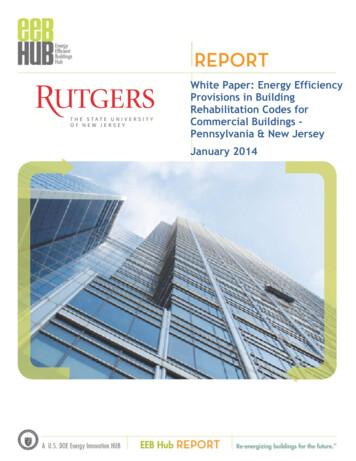
Transcription
White Paper: Energy EfficiencyProvisions in BuildingRehabilitation Codes forCommercial Buildings Pennsylvania & New JerseyJanuary 2014
Energy Efficiency Provisions in Building Rehabilitation Codes for Commercial BuildingsJanuary 2014Citation:Rutgers Center for Green Building, David B. Hattis, David Listokin, Jennifer Senick, with theassistance of Michael Manzella. 2014. White Paper: Energy Efficiency Provisions in BuildingRehabilitation Codes for Commercial Buildings - Pennsylvania & New Jersey. Prepared by theCenter for Green Building at Rutgers University for the Energy Efficient Buildings Hub,Philadelphia, PA.Acknowledgment:This material is based upon work supported by the Energy Efficient Buildings Hub (EEB Hub),an energy innovation hub sponsored by the U.S. Department of Energy under Award NumberDE-EE0004261.Disclaimer:This report was prepared as an account of work sponsored by an agency of the United StatesGovernment. Neither the United States Government nor any agency thereof, nor any of theiremployees, makes any warranty, express or implied, or assumes any legal liability orresponsibility for the accuracy, completeness, or usefulness of any information, apparatus,product, or process disclosed, or represents that its use would not infringe privately owned rights.Reference herein to any specific commercial product, process, or service by trade name,trademark, manufacturer, or otherwise does not necessarily constitute or imply its endorsement,recommendation, or favoring by the United States Government or any agency thereof. The viewsand opinions of authors expressed herein do not necessarily state or reflect those of the UnitedStates Government or any agency thereof.1
Energy Efficiency Provisions in Building Rehabilitation Codes for Commercial BuildingsJanuary 2014Table of ContentsExecutive Summary . 3A.Building Regulations—General Background . 6B.Development of Smart Rehabilitation Codes . 12C. Summary of Building Regulations for Commercial Buildings in Pennsylvania and NewJersey. 24D.Energy Conservation Retrofit Regulations for Commercial Buildings . 26E. Summary of Energy Conservation Retrofit Regulations for Commercial Buildings inPennsylvania and New Jersey . 30F. Code Compliance Reconnaissance—Commercial Building Energy Code Compliance FocusGroups and Survey of Pennsylvania Building Officials . 31G.Recommendations from Regulatory Review and Reconnaissance Field Discussion . 332
Energy Efficiency Provisions in Building Rehabilitation Codes for Commercial BuildingsJanuary 2014Executive SummaryBoth Pennsylvania (Department of Labor and Industry) and New Jersey (Division of Codes andStandards, Department of Community Affairs) have adopted statewide mandatory codesapplicable to the new construction and rehabilitation of commercial buildings, as shown inSummary Table 1. In Pennsylvania the codes may be locally amended and are enforced by localgovernment in jurisdictions that have “opted in”, or by the Department of Labor and Industry injurisdictions that have “opted out”. Most Pennsylvania jurisdictions have “opted in”, and some ofthem have contracted with private third parties for enforcement plan reviews and inspections. InNew Jersey the codes cannot be locally amended and are enforced by local governments withsome private contracting of inspections.Summary Table 1.Building Regulations Applicable to Commercial Buildings in Pennsylvania and New Jersey.PennsylvaniaNew JerseyNew ConstructionInternational Building Code 2009International Energy Conservation Code2009 Other I-codesInternational Building Code 2009ASHRAE 90.1-2007Other I-codesRehabilitationInternational Existing Building Code 2009Rehabilitation SubcodePennsylvania and New Jersey present a picture of what may be the two extremes in theregulations governing energy efficiency retrofit of commercial buildings. This becomes evidentbased on a summary of the development of building regulations in the United States, and thedevelopment of “smart rehabilitation codes” in the late 1990s. New Jersey led the developmentof smart rehabilitation codes with its Rehabilitation Subcode in 1998. It was based on the conceptof achieving predictability and proportionality in the requirements applicable to constructionwork in existing buildings.Initially it was thought that the New Jersey approach, supported by the US Department ofHousing and Urban Development (HUD) with its Nationally Applicable RecommendedRehabilitation Provisions (NARRP), would become a national model through the development ofthe International Existing Building Code (IEBC) in 2003, but subsequent amendments in 2006,2009 and 2012 have moved the IEBC away from proportionality, and, to some extent frompredictability.3
Energy Efficiency Provisions in Building Rehabilitation Codes for Commercial BuildingsJanuary 2014New Jersey has maintained its Rehabilitation Subcode while Pennsylvania applies the 2009edition of the IEBC. What this means for the regulation of energy retrofit in existing commercialbuildings is that in New Jersey the requirements are limited, predictable, and well-defined. InPennsylvania the energy retrofit requirements are unpredictable, subject to discretion of theregulators, and may be more or less extensive. In the case of alterations, Pennsylvania requiresalterations to comply with the new building requirements of the International EnergyConservation Code, with eight specific exceptions, while New Jersey requires compliance withAmerican Society of Heating, Refrigerating and Air Conditioning Engineers (ASHRAE 90.1) infour specific alterations. In the case of change of occupancy, Pennsylvania requires fullcompliance with the International Energy Conservation Code when the change involves increasein the use of fossil fuel or electrical energy, while New Jersey has no requirements applicable toa change of occupancy. Summary Table 2 displays a summary of energy conservation retrofitregulations for commercial buildings in Pennsylvania and New Jersey.4
Energy Efficiency Provisions in Building Rehabilitation Codes for Commercial BuildingsJanuary 2014Summary Table 2.Energy Conservation Retrofit Regulations for Commercial Buildings in Pennsylvania and NewJersey.Governing CodesPennsylvaniaNew JerseyInternational Energy Conservation CodeInternational Existing Building CodeRehabilitation SubcodeASHRAE 90.1Enforcement BasisJudgment/unpredictable: SpecificPrescriptive/predictable: Four specificexceptions for alteration compliance with alterations require compliance with newnew building requirements may bebuilding requirements.ambiguous as to what is required, andcommentary in the International ExistingBuilding Code addresses reconfiguration ofspace which is not mentioned as analteration in the International EnergyConservation Code.AlterationsAlterations to existing buildings arepermitted without requiring the entirebuilding to comply with the energyrequirement of the International EnergyConservation Code. The alterations shallconform to the energy requirements of theInternational Energy Conservation Code.There are eight of specific exceptions.In certain cases where the reconfigurationof space might have resulted in creation ofnew spaces, the newly created spaceshould be evaluated as a whole forcompliance with the energy provisions,even though some of the elements withinthe space might actually not have beenaltered.Change of Occupancy When the work exposes the roofdecking/sheathing or the framingof any wall, floor, ceiling, orroof assembly that is part of thebuilding thermal envelope . When fenestration is newlyinstalled or replaced. Ducts that are newly installed orreplaced. The total replacement of abuilding lighting system or anewly installed building lightingsystem.Buildings undergoing a change inNo requirements for the new occupancy.occupancy that would result in an increasein demand for either fossil fuel or electricalenergy shall comply with the InternationalEnergy Conservation Code for the newoccupancy.5
Energy Efficiency Provisions in Building Rehabilitation Codes for Commercial BuildingsJanuary 2014A. Building Regulations—General BackgroundThe regulation of building construction in the United States is an exercise of government policepower, and with very few exceptions (e.g., accessibility for the disabled and manufacturedhousing), it is legislated at the local or state government levels. It traditionally has beenaccomplished by means of a set of inter-related codes, each addressing a specific building systemor a specific building attribute. While these codes may be packaged in different ways in differentjurisdictions, they generally can be described as follows: A building code that addresses the building’s structural system, fire safety, general safety,enclosure, interior environment, and materials. A plumbing code that addresses the building’s potable water supply and waste systems. A mechanical code that addresses the building’s combustion and mechanical equipment. An electrical code that addresses the installation of electrical wiring and equipment inbuildings, and a gas code that does the same with respect to the installation of gas pipingand gas-burning equipment. An energy code that addresses all parts of the building that consume, or contribute to theconsumption of energy. Other specialty regulations, such as an accessibility code, that addresses buildingaccessibility to the physically disabled.Because of the technical complexity of these codes and the time and money needed to keep themupdated, most state and local governments have abandoned the development and maintenance oftheir own codes, and rely on adoption (with or without amendment) of a model code (developedby a regional or national association). All of these codes make use of extensive references tovoluntary consensus standards on design methods, test methods, materials, and systems. Byreference, these standards become part of the building regulatory system. These codes typicallyare enforced at the local level in a process that begins with the application for a building orconstruction permit, and followed by plan review, permit issuance, inspections, and certificate ofoccupancy issuance.A related but different set of regulations that sometimes are packaged together with the abovedescribed measures are those that control the use and maintenance of existing buildings. Parts ofthese codes sometimes may overlap with the plumbing, mechanical, or electrical codes, such thatsome aspects of operation and maintenance are included therein. They generally can be describedas follows: A fire prevention code, sometimes called a fire code, which regulates the building’s firesafety throughout its occupancy and use. A housing code that regulates the health and sanitation of residential buildings throughouttheir occupancy and use.6
Energy Efficiency Provisions in Building Rehabilitation Codes for Commercial BuildingsJanuary 2014 A property maintenance code that expands the scope of the housing code to include othertypes of buildings. A hazard abatement code that identifies building conditions that are so hazardous thatimmediate remedial action may be required.These codes are generally enforced at the local level by means of periodic inspections andcitation of violations.A third category of building regulation is referred to as retroactive regulations. These generallyaddress hazards in existing buildings that, while not necessarily imminent, are identified bysociety as needing remediation. Some examples of such regulation are the enclosure of openstairs in public buildings, the installation of sprinklers, the reinforcement of unreinforcedmasonry buildings in zones of high seismicity, and the stabilization of exterior wall finishes inhigh-rise buildings. Due to the extremely high costs imposed by such regulations on buildingowners, retroactive regulations are quite rare and local in nature.Historical DevelopmentThe current building regulatory system in the U.S. is the product of several diverse trends. Whenviewed in a historical perspective, it may be thought of (somewhat allegorically) as resting onfour foundations, and as supported by three buttresses. The foundations include the: Insurance industry Tenement and housing movements Engineering profession Construction industryThe buttresses are the: Federal government Model codes groups Voluntary standards organizationsThe Insurance Industry. In the 19th century, the insurance industry was the regulator of firesafety in buildings, with an institutional framework created to regulate, as well as to provideresearch and technical support. For over the past half century, the regulation of fire safety inbuildings has been a function of state or local governments, while some of those originally7
Energy Efficiency Provisions in Building Rehabilitation Codes for Commercial BuildingsJanuary 2014insurance-related organizations continue to perform regulatory support functions to this day: theNational Board of Fire Underwriters (today called the American Insurance Association); theNational Fire Protection Association (NFPA); and Underwriter Laboratories. The early concernsof these organizations were related to property risk and the risk of conflagration. Concern for lifesafety became articulated and institutionalized in 1913. It was the National Board of FireUnderwriters that developed and published in 1905 the first model building code in the U.S.: theNational Building Code, which also included housing and structural requirements in addition tofire safety, and continued to be updated and published until 1976.The insurance industry also was the earliest regulator of electrical safety in building, where thediversity of early local regulations was overcome when many entities came together to create thefirst National Electrical Code in 1897 in a conference that anticipated in some ways today’sconsensus processes. The National Electrical Code has been periodically updated to this day, andhas been published exclusively by NFPA since 1965.Today, in addition to the continued activities of the early organizations, other insurance industryorganizations continue to be active in the building regulatory arena. The Institute for Businessand Home Safety (IBHS) was created specifically to support the development of regulations inthe natural disaster areas of earthquakes, hurricanes, and floods. The Insurance Services Offices(ISO) evaluates building code enforcement programs in states and local jurisdictions throughoutthe U.S., and provides relative ratings to assist insurance underwriting.The Tenement and Housing Movements. These movements arose in various U.S. cities towardthe end of the 19th century in response to blatantly unhealthy housing conditions. Charitableorganizations were established, and many of them joined to form the National HousingAssociation in 1900 to press for housing reform. Tenement laws developed in American cities inthe second half of the 19th century, and in the early years of the 20th century began to reflectthese concerns by regulation of health and sanitation, as well as the fire protection aspects ofhousing. The New York Tenement House Act of 1901 served as a model for many other cities.Tenement laws also were included in the 1905 National Building Code. Since 1939, theAmerican Public Health Association (APHA) has been concerned with housing standards, andusually is credited with development of the prototype for modern housing codes, as well as thehealth and sanitation requirements in model building codes (including room dimensions andarrangements). In recent years, the latter have been reduced in scope, based on the assumptionthat they were provided for adequately by the marketplace.The Engineering Profession. Civil and structural engineering provided the foundation for thestructural requirements of building regulations. By the second half of the 19th century, structuralanalysis and design methods had been developed for various structural materials. These wereaccepted by a consensus of the profession and were incorporated into early city building codes8
Energy Efficiency Provisions in Building Rehabilitation Codes for Commercial BuildingsJanuary 2014and the 1905 National Building Code. In more recent years, engineering associations have beeninvolved in developing consensus standards for structural design (American Society of CivilEngineers (ASCE)), mechanical codes and standards (American Society of Heating,Refrigerating, and Air-Conditioning Engineers (ASHRAE) and American Society of MechanicalEngineers (ASME)), and plumbing codes and standards (American Society of PlumbingEngineers (ASPE)).The Construction Industry. The construction industry always has had a vital interest in buildingregulations, often as a way of furthering—and at other times, limiting—the use of certainmaterials and construction trades. Perhaps the industry’s strongest influence can be seen directlyin the plumbing codes, though self-serving provisions can be found in all the codes. Plumbingcodes developed early at the local level. The earliest on record is that of Washington, DC, ineffect in 1870. Since its organization in 1883, the National Association of Master Plumbers hadbeen concerned with plumbing codes. Nevertheless, extreme diversity reflecting local practicesand conditions typified the early plumbing codes.The National Association of Master Plumbers itself did not publish a model plumbing code until1933. The National Association of Plumbing-Heating-Cooling Contractors, successor to theNational Association of Master Plumbers, has been publishing the National Standard PlumbingCode, which is used in many jurisdictions, since the 1970s.The Federal Government. The federal government has played two roles in buttressing thecurrent building regulatory system: provider of technical expertise and formulator of nationalpolicies.As a provider of technical expertise, the National Institute of Standards and Technology (NIST)(formerly the National Bureau of Standards (NBS)), has played a paramount role. Starting withthe testing of materials and structural systems in the early part of the 20th century, NIST’s rolehas expanded. Most of the publications of NBS’ unique Building and Housing Series from 1921to 1932 directly addressed the regulatory system (building code organization and format,structural provisions, fire resistance provisions, and a model plumbing code—the “HooverCode” of 1928). These have had great influence on subsequent modern codes. Since then, NISThas continued to develop technical materials in various areas directly usable by the buildingregulatory system. Today, NIST provides leadership to, or participation in, multiple voluntarystandards activities at the American Society for Testing and Materials (ASTM) International,NFPA, ASHRAE, ASCE, and other voluntary standards organizations that support the regulatorysystem.As a formulator of national policies, various federal agencies have often interfaced with buildingregulations or influenced them directly. Notable in this capacity is the U.S. Department ofHousing and Urban Development (HUD), which developed its own Minimum Property9
Energy Efficiency Provisions in Building Rehabilitation Codes for Commercial BuildingsJanuary 2014Standards for underwriting its mortgage insurance programs, and has pressed fo
New Jersey led the development of smart rehabilitation codes with its Rehabilitation Subcode in 1998. It was based on the concept of achieving predictability and proportionality in the requirements applicable to construction work in existing buildings. Initially it was thought that the New Je

